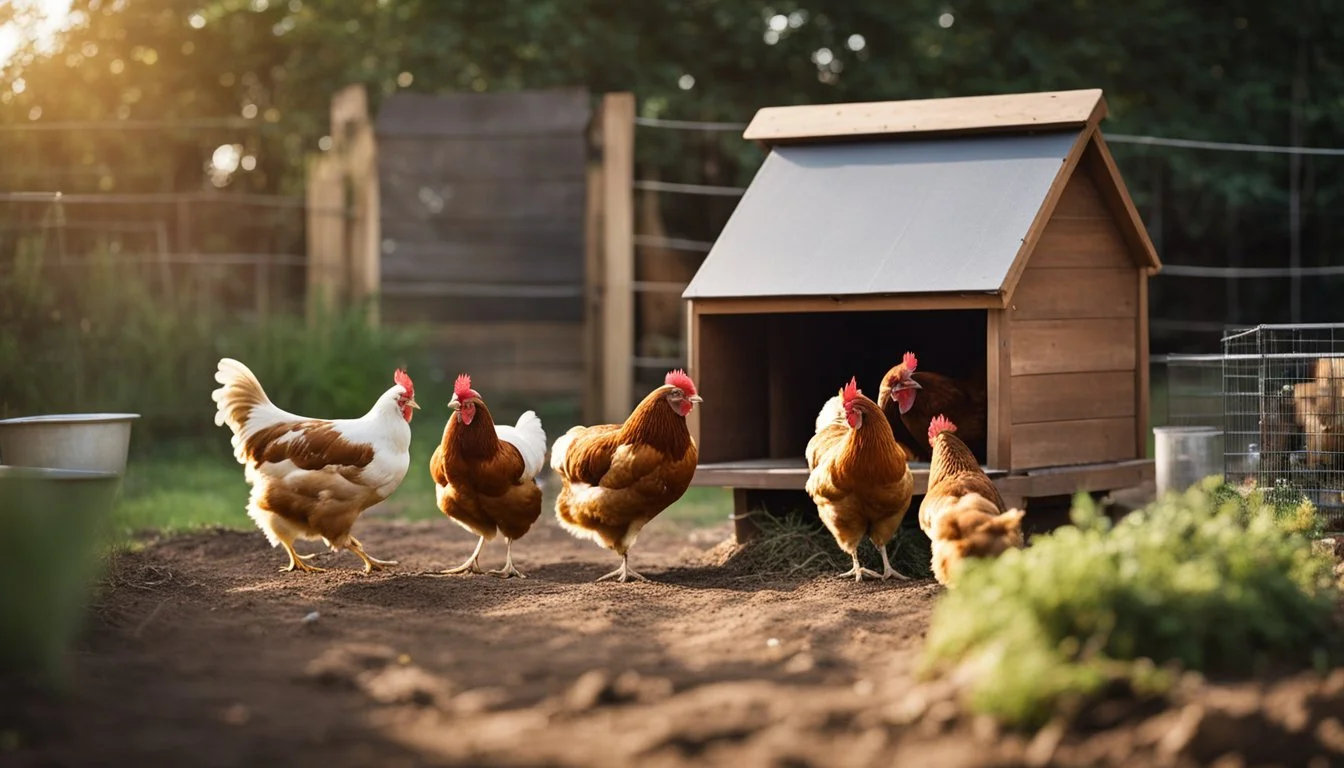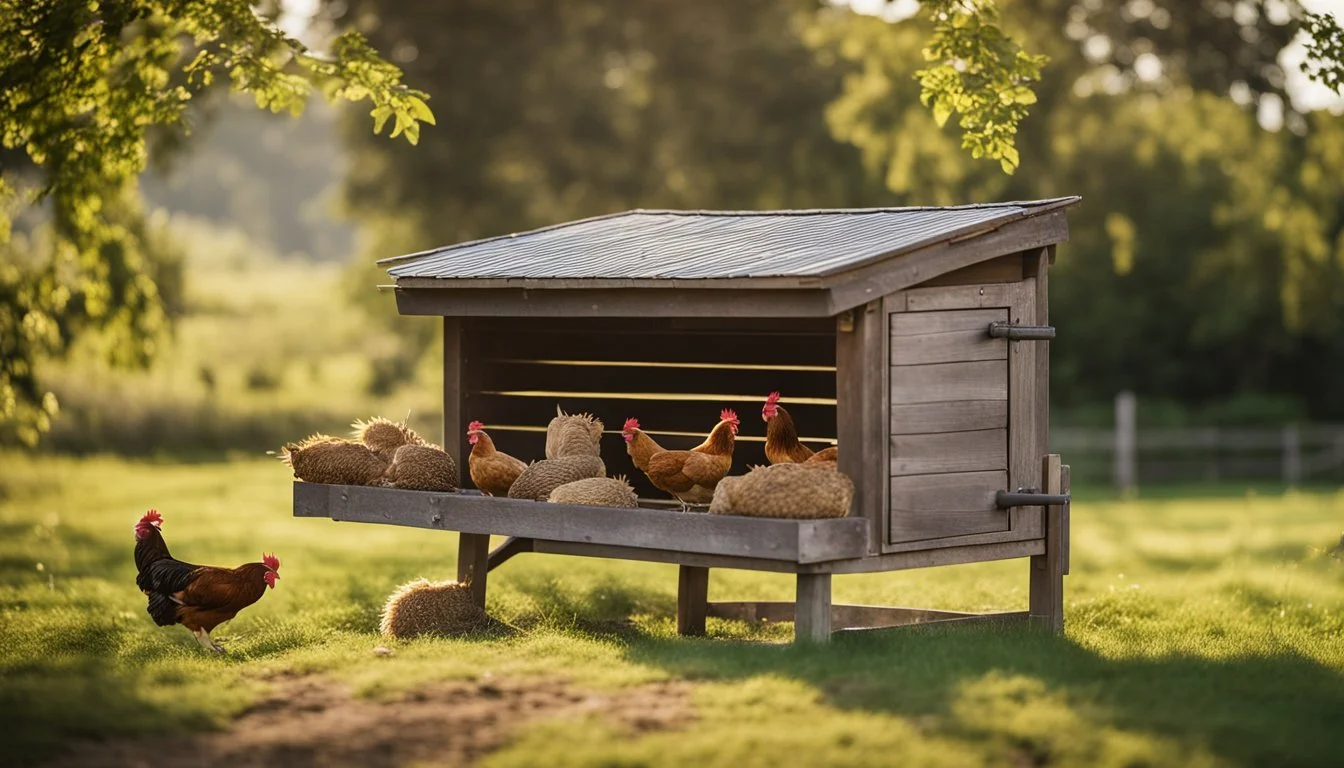8 Tips for Raising Chickens on a Budget
Cost-Effective Strategies for Beginners
Raising chickens can be an enriching and sustainable hobby, but many prospective chicken keepers worry about the associated costs. There are various strategies to manage a backyard flock without stretching the budget. With thoughtful planning and practical measures, you can enjoy the benefits of fresh eggs and healthy poultry without significant financial strain.
Understanding how to optimize expenses while still providing excellent care for your chickens is vital. This article introduces key tips that are designed to keep costs low while ensuring your flock remains healthy and productive. From initial setup to ongoing maintenance, these strategies will help you efficiently manage your resources.
1) Build a DIY Chicken Coop
Constructing a DIY chicken coop can significantly cut costs. With basic materials, such as wood and chicken wire, it's possible to create a sturdy, functional shelter for your chickens. Many free plans are available that include detailed drawings and step-by-step instructions.
A coop needs to provide enough space. Generally, each chicken requires 3-4 square feet. For example, a flock of 6 chickens would need at least 18-24 square feet. Additionally, larger coops often require more in-depth plans, but they remain manageable for most DIY enthusiasts.
Roof construction is another important aspect. Simple designs use angles and trusses to form a stable roof. Assembling these trusses and securing them to the coop frame ensures adequate protection from weather. Including a ridge rail further increases stability.
Security is crucial too. Predators can target weak points like doors and windows. Secure latches and tight-fitting doors help prevent intrusions. Raccoons and other animals are adept at manipulating basic latches, so using more complex mechanisms can be beneficial.
Recycling materials can make the coop more affordable. Old pallets, scrap wood, and leftover construction materials can reduce costs while maintaining functionality. Ensuring all gaps and openings are covered with chicken wire helps protect the flock from small predators.
2) Use Inexpensive, Local Chicken Feed
Finding affordable chicken feed locally can significantly cut costs. Local grain mills often offer bulk feed options. These are typically cheaper than branded feeds available at big box stores.
Farmers' markets may also provide cost-effective feed choices. Many local farmers sell surplus grains and seeds at lower prices. These can be a great option for budget-conscious chicken owners.
Free-ranging chickens can further reduce feed expenses. Allowing chickens to forage for insects, weeds, and other natural food sources not only cuts costs but also promotes healthier birds.
Kitchen scraps can supplement your chicken’s diet. Vegetables, fruits, and grains from your kitchen can be a nutritious addition to their feed. Ensure that these scraps are safe and suitable for chickens.
Another cost-effective option is fermenting grains. Fermenting can increase the nutritional value of the feed, making it more efficient and economical. Chickens often eat fermented feed more readily, which helps in reducing waste.
Deer corn is another local feed option. It's often available in bulk during hunting season. Cracking the corn before feeding can make it easier for chickens to digest.
Using a mix of these strategies can help maintain a nutritious and budget-friendly diet for chickens.
3) Recycle Kitchen Scraps for Feed
One effective way to cut costs while raising chickens is by recycling kitchen scraps as feed. Chickens love a variety of food scraps such as bread, grains, and leftovers like rice or pasta. Providing these scraps not only saves money but also reduces household waste.
Fruits such as blueberries, watermelon, strawberries, and apples make excellent treats. Vegetables like corn, beets, broccoli, and carrots are also highly appreciated by chickens. These additions can complement their regular diet, ensuring they get diverse nutrients at no extra cost.
Avoid feeding chickens harmful scraps. Dry or uncooked beans, which contain toxic hemaglutin, should be avoided unless thoroughly cooked. Other items to avoid include caffeinated products, chocolate, and sugary treats like cookies or candy, which can be harmful to their health.
Using food scraps effectively requires some consideration. Ensure scraps are fresh and free from mold. By incorporating kitchen leftovers into your chicken’s diet, you can significantly reduce feed expenses while promoting a sustainable lifestyle. This practice not only benefits the environment but also supports economic and animal husbandry goals.
4) Install Rain Barrels for Water
Installing rain barrels is a cost-effective way to provide water for chickens. Rainwater collection systems can help save on water bills and provide a sustainable water source.
Setting up a rain barrel system is simple. Place barrels under downspouts to collect rainwater from roofs. Ensure the installation is secure to prevent tipping.
Rainwater is generally safe for chickens. Regularly check the cleanliness of the barrels. If you live in an industrial area, monitor air quality, as rain might carry pollutants.
Adding a small amount of unscented chlorine bleach can keep the water safe for long-term storage. Mix about a tablespoon of bleach per five gallons of water.
Utilize basic plumbing supplies to connect rain barrels to your watering system. This allows for efficient water distribution to your chickens through hoses or pipes.
For automated systems, use float valves to maintain a consistent water level. This ensures your chickens always have access to fresh water without manual refilling.
5) Opt for Free-Range Raising
Free-range raising can be an economical way to provide for your chickens, as it reduces the need for expensive infrastructure. By allowing chickens to roam freely, they can forage for a significant portion of their diet.
This natural foraging behavior includes eating insects, seeds, and plants, which can cut down on feed costs.
Free-range environments also typically lead to healthier chickens. Chickens that roam more widely are known to have better access to exercise and natural food sources. This can result in fewer health issues and lower veterinary costs.
When setting up a free-range system, electric fences, especially mobile electric poultry netting, can be very helpful. These fences help protect chickens from predators while giving them ample space to roam.
It’s crucial to ensure that the area where the chickens are free-ranging is safe and free from harmful substances. A well-secured perimeter can keep out potential threats such as predators and toxic plants.
Adopting a free-range system doesn't necessarily require extensive land. Smaller backyards can also accommodate free-range chickens by rotating grazing areas. This helps manage the land and prevents overgrazing.
By opting for free-range raising, you can leverage the natural behaviors and diets of chickens to maintain a cost-effective and healthy flock. This approach not only cuts down on feed and healthcare expenses but also enriches the lives of your chickens.
6) Use natural predators for pest control
Leveraging natural predators can be a cost-effective way to manage pests in your chicken coop and garden.
Introducing ladybugs can help control aphid populations. Ladybugs naturally feed on aphids, providing an efficient, chemical-free solution.
Encouraging beneficial insects like praying mantises and spiders can keep pest numbers low. These predators feed on a variety of harmful insects, maintaining a healthy balance.
Consider using chickens themselves as pest controllers. Many chicken breeds are effective at reducing bug populations, as they naturally hunt insects.
Diatomaceous earth is another option. While not a predator, it is a natural substance that deters pests like mites and lice. It is affordable and safe for chickens.
Combining these methods can create an integrated pest management system, reducing dependency on chemical treatments. This holistic approach supports a healthier environment for your chickens and garden.
7) DIY Nesting Boxes from Old Pallets
Old pallets can be transformed into practical and cost-effective nesting boxes for chickens. With a few simple tools, these pallets can be repurposed to create sturdy nesting spaces without breaking the bank.
Pallet wood is often readily available and inexpensive. Many businesses give them away for free, making it a budget-friendly option for chicken owners.
Ensure each box measures about 1-foot by 1-foot to fit the average chicken. This dimension provides sufficient space for hens to lay their eggs comfortably.
Disassemble the pallets carefully to avoid splitting the wood. Use a hammer and pry bar to separate the planks, preserving their integrity for sturdy construction.
Secure the sides of the box with nails or screws. Adding a bottom and a back will give the box stability.
Place the completed nesting boxes in a quiet, dimly lit area of the coop. Filling them with hay or straw provides a comfortable bedding for the chickens.
Old pallets offer a sustainable way to equip a chicken coop with necessary nesting boxes while keeping expenses low.
8) Barter or trade for supplies
One effective way to save money when raising chickens is to barter or trade for supplies. Many people have items they no longer need, which can be exchanged for things of value.
Knowing the worth of your goods or services is crucial. Whether you're offering eggs, homemade crafts, or manual labor, understanding the value of your trade will help in negotiations.
Local communities and social media groups are great places to find others interested in trading. Farmers' markets and agricultural events are also locations where bartering is commonly practiced.
Trading can help you acquire essential items like feed, coop materials, or healthcare supplies for your chickens. Always ensure that the traded items are of good quality to maintain the well-being of your flock.
Bartering is not only cost-effective but also fosters a supportive community network. People often prefer to trade within their community, creating lasting connections and mutual benefits.
Choosing the Right Breed
Selecting the appropriate chicken breed involves considering your space and specific needs, as well as understanding various breed characteristics. This ensures your chickens are well-suited to your environment and purposes.
Assessing Your Needs and Space
Before choosing a breed, it's essential to determine your goals for raising chickens and assess the available space. If your primary aim is egg production, breeds known for high egg yield, such as Leghorns or Rhode Island Reds, are ideal. For meat production, Cornish Cross or Jersey Giants are good choices.
Additionally, evaluate your climate and space. Breeds like Orpingtons and Australorps are hardy and withstand cold weather, while breeds such as Leghorns thrive in warmer climates. Consider whether you have a large backyard or a small urban space, as some breeds need more room to roam.
Understanding Breed Characteristics
Knowing the traits of different breeds helps in making an informed decision. Egg-laying breeds like Isa Browns can produce up to 300 eggs annually, making them excellent for consistent egg supply. Broody breeds, such as Silkies, are ideal if you're interested in natural chick hatching.
Temperament also matters; some breeds like Sussex and Plymouth Rocks are friendly and suitable for families with children, while others can be more skittish. Review potential health issues as well—certain breeds are more prone to specific ailments and might require more care.
In summary, careful consideration of your space, climate, and goals ensures that you select the right breed for your needs.
Feeding Chickens Economically
Feeding chickens on a budget is achievable by using kitchen scraps and making your own chicken feed. Implementing these strategies can significantly reduce costs while maintaining a healthy diet for your flock.
Utilizing Kitchen Scraps
Kitchen scraps can be a valuable resource for feeding chickens economically. Vegetable peels, fruit rinds, leftover rice, and stale bread are all suitable options. Avoid feeding chickens anything that is spoiled, excessively salty, or sugary.
When using kitchen scraps, make sure they are chopped into small, manageable pieces to facilitate easy consumption. Eggshells can also be included, as they are an excellent source of calcium. Simply crush the shells before adding them to the feed.
Maintaining a balance is key to ensuring chickens get a well-rounded diet. Don't rely solely on kitchen scraps; they should supplement the primary feed.
Making Your Own Chicken Feed
Another effective method for reducing feed costs is by making homemade chicken feed. Grains such as corn, wheat, and oats can be purchased in bulk and mixed together. Adding legumes like peas and lentils can enhance the protein content.
Fermented grains are another cost-effective option. Soaking grains in water until they ferment can increase their nutritional value and decrease the quantity needed. Avoid using raw eggs directly; cook them before mixing into feed to prevent the risk of hens developing egg-eating habits.
Combine the homemade feed ingredients in a large container, ensuring they are well mixed. Store in a cool, dry place to maintain freshness. By tailoring the mix to your flock's needs, you can provide a nutritious diet while keeping expenses low.
Housing and Shelter on a Budget
Creating cost-effective housing for your chickens can be accomplished through building DIY coops and runs and utilizing recycled materials. These strategies help minimize expenses while ensuring a safe and comfortable environment for your flock.
DIY Coops and Runs
Building a chicken coop and run yourself can significantly cut costs. Materials can range from wood and wire mesh to simple roofing materials. The price for a DIY run can range from $50 to $500, depending on the size and materials.
Plan the structure meticulously:
Space: Ensure at least 2-3 square feet per chicken in the coop.
Ventilation: Proper airflow is essential to prevent diseases.
Protection: Secure the coop to protect from predators using sturdy locks and hardware cloth.
Investing in essential tools like hammers, nails, and saws can streamline the building process. Repurpose existing materials whenever possible.
Recycling Materials for Coops
Using recycled or repurposed materials is an excellent way to save money while constructing a chicken coop. Look for scrap wood, old pallets, and second-hand roofing materials, which can often be found at construction sites or through online marketplaces.
Examples of materials include:
Scrap lumber for framework.
Old windows for natural light and ventilation.
Reclaimed metal roofing for durable, weatherproof shelter.
Consider eco-friendly options like using an old shed or repurposing a wooden playhouse. Making thoughtful use of available resources not only saves money but also supports sustainable practices. This approach ensures chickens have secure, comfortable housing at a fraction of typical costs.






